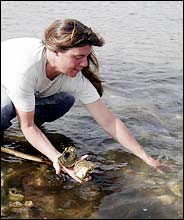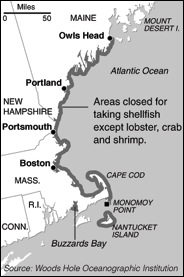Disclaimer: These postings were sent to us from a variety of media sources over the Internet. The content has not been reviewed for scientific accuracy or edited in any manner.
Red Tide Shuts Shellfish Areas in New England
June 4, 2005
By PAM
BELLUCK - New York Times
BOSTON, June 3 - New England waters are being plagued by what may be the worst outbreak of red tide in the region, a Massachusetts official said Friday.
The toxic algae bloom has led state officials to close shellfish beds between Maine and Cape Cod so that people do not eat infected clams, mussels, oysters and scallops.
 | "Everything is just really on hold until this algae bloom clears up," said Barbara Austin, who farms oysters and littleneck clams in Wellfleet, Mass. |
 Scientists and state officials say the outbreak, possibly caused by an
unusually cold and wet winter and spring, is worsening and, at minimum,
is expected to last several weeks. The chief shellfish biologist in
Massachusetts, J. Michael Hickey, said two-thirds of the shellfish beds
in the state had been closed, including, late on Friday, all the
shellfish flats off Nantucket Island.
Scientists and state officials say the outbreak, possibly caused by an
unusually cold and wet winter and spring, is worsening and, at minimum,
is expected to last several weeks. The chief shellfish biologist in
Massachusetts, J. Michael Hickey, said two-thirds of the shellfish beds
in the state had been closed, including, late on Friday, all the
shellfish flats off Nantucket Island.Fishermen in the oyster- and clam-rich centers of Cape Cod are out of work, and fish markets and restaurants on the cape are scrambling to find more expensive substitutes, and, in turn, selling the fish at higher than usual prices.
"It is spreading, and it is getting worse," Mr. Hickey said. "I think this one's going to be probably the biggest in terms of area and probably, the way it's going, in terms of toxicity levels."
This species of algae, unlike a variety of red tide that occurs off Florida, does not emit fumes that kill ocean life or prevent people from swimming. Beaches have not closed. And it affects only bivalves, not other seafood like lobsters or shrimp.
If shellfish infected with the New England strain is eaten, the toxin could cause numbness, breathing problems or even death, said Dr. Don Anderson, a senior scientist at the Woods Hole Oceanographic Institution, who, along with other scientists, has received emergency federal money to help monitor the problem.
No illnesses have been reported from this outbreak.
Dr. Anderson said that in light of a few serious cases several years ago - the deaths of a few people in Alaska and California who had ignored or did not know about closings of shellfish areas in those states - New England officials are being careful to place contaminated beds off limits.
"This is certainly a major event," he said.
The closings are cramping the shellfish industry, which earns much of its revenue from soft-shell clams that Cape Cod vacationers clamor for in the summer.
"It's tens of thousands of dollars a day just in Wellfleet," said Molly Benjamin, who farms oysters and littlenecks there. "It's 'killing' people. I mean nobody was ready."
Different species of red tide bloom in different parts of the world. The New England variety, Alexandrium, often permeates the waters off Maine or New Hampshire, experts say. But it rarely spreads with such ferocity and almost always drifts out to the ocean before infiltrating the prolific shellfish bastions around Cape Cod.
Dr. Anderson said that in a normal year the algae concentration in the water might be "1,000 cells or 2,000 cells in a liter."
With this outbreak, he said, "we're seeing 20 to 40 times that many cells per liter."
For days, Mr. Hickey and others have been saying that the outbreak was not as bad as one in 1972, the first time that officials think that red tide encroached on Massachusetts waters. Then, the water around Cape Ann, 30 miles northeast of Boston, was tinged reddish and some seabirds died. This time, the water has not changed color, and no birds are known to have died.
Although the state closed all the shellfish flats in 1972, Mr. Hickey said, some of those were closed as a precaution, not because contamination was found.
"I would say right now we got more area closed because of actual toxin than you had in 1972," Mr. Hickey said.
"It's just a pretty sad situation," said Barbara Austin, who has been farming oysters and littleneck clams for 20 years in Wellfleet. "Everything is just really on hold until this algae bloom clears up, and they don't have any way of knowing how long it's going to take."
Ms. Austin, out of work for a week, took a temporary job "doing some house-cleaning and taking care of some animals for some folks," she said.
"I just never imagined that it could possibly happen in Wellfleet," she said. "What's really scary is the economic impact for this town. It trickles right down to the guys who we employ, who hand-count clams into bags. We have truck drivers, managers. We've been trying to find other things for them to do. But if this is an extended closure, they're going to have to go on unemployment. It trickles down right to coffee shops where people say: 'I've got to save my money. I can't afford to buy a sandwich.' "
At the Friendly Fisherman, a fish market and restaurant in Eastham, Colleen Francke said clams for frying have been bought from Canada at double the price per gallon that the local ones cost last summer. Her business is selling steamers for $5.29 a pound, up from a high of $3.99 last year.
"The prices are just skyrocketing," she said.
Dr. Anderson said that in some places people were "misinformed and are overreacting," avoiding all fish, not understanding that lobster and other seafood are unaffected and that the clams and oysters on sale have been rigorously tested and are safe. The misperception could make it even harder for fishermen, he said.
Officials predict that currents will sweep the red tide out to sea in coming weeks and that it will not drift south along the coast. Mr. Hickey said that just in case, he was communicating with environmental officials in New York, who are "obviously very interested in what's going on."
Dr. Anderson, who said the snowy winter and rainy May may have brought in algae-nourishing nutrients from the sea, said he was concerned that a second wave of red tide might hit Cape Cod, because a second outbreak is under way in Maine.
Several fish entrepreneurs on the cape said they hoped that the red tide has cleared by the Fourth of July, when summer vacationers arrive in earnest, because out-of-towners are quite likely to be less understanding of the problem than their regular customers.
"We know that being in a coastal area, especially a seasonal area, it has its highs and lows, and that's probably why we're here and what we love about it," said Jim Russo, who manages the Lobster Shanty in Eastham and the Orleans Lobster Pound on the cape.
Mr. Russo said his current customers were not panicking or staying away. Still, he said, even he could grow sentimental about shellfish.
"If I could pick it," Mr. Russo said, "even over chocolate, I'd pick clams."